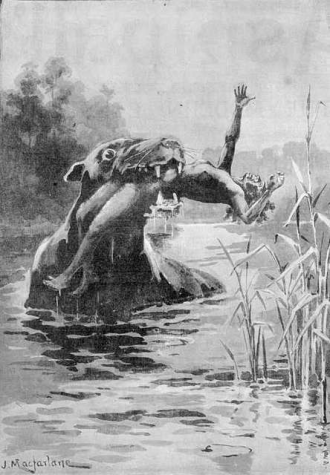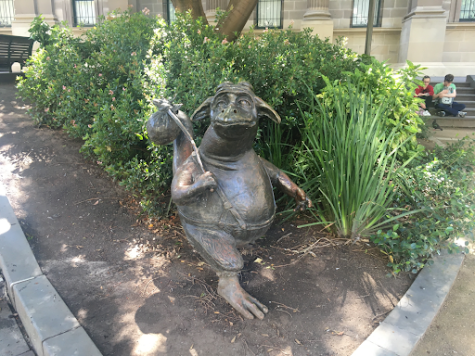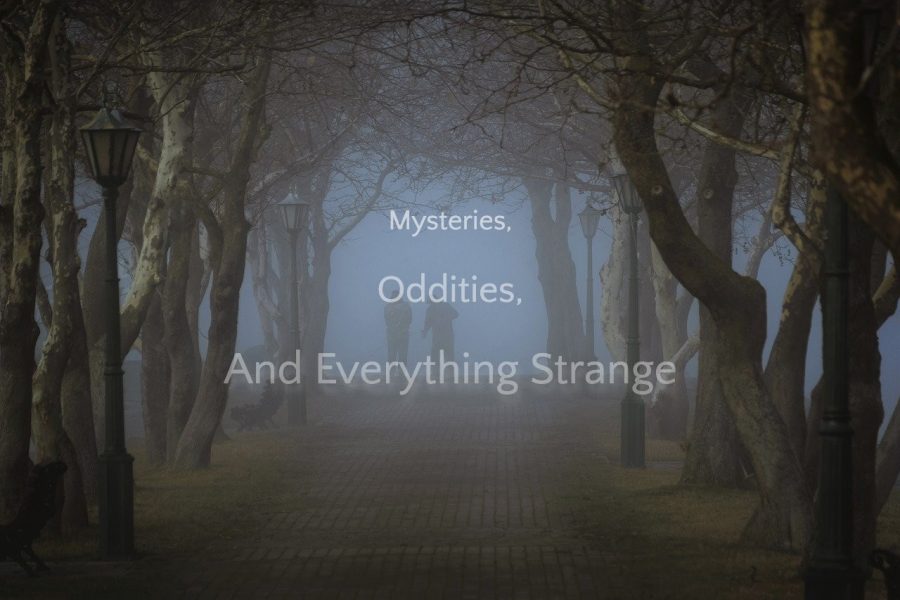Mysteries, Oddities, and Everything Strange: Bunyip
May 15, 2022
Bunyip: A Billabong Beast
There is one place practically everyone knows to be full to the brim of terrifying, massive creatures: Australia. Whether it be hideous spiders, giant worms, or birds that dive bomb your head and cause hospitalizations, Australia has a terrifying plethora of creatures that just might not be of this Earth. Despite this, the people of the continent have learned to deal with the title of the most freakish animals on the planet. Even with this honor, Australia still has its fair share of outlandish folklore, and the Bunyip is one such example. But why does it have such a funny name, and what exactly is it?
 A bunyip is a water-dwelling creature from southeastern Australia with over two hundred years’ worth of documented sightings. The name is derived from the local languages of native Australian people, most notably the Wergaia and Wemba-Wemba who resided in modern-day Victoria. Its closest meaning is “evil spirit” or something similar to the word “devil” in modern English. The name of the bunyip is quite similar to that of the ancient heroic deity from the same of Australia’s Aboriginal people, Bunjil. There are many arguments over what the inspirations and origins of the bunyip are exactly, ranging from seals to marsupials to a flightless bird known as the southern cassowary. Despite this verbal battle, the legends and stories of the bunyip have been universally agreed upon among witnesses, anthropologists, and cryptozoologists alike.
A bunyip is a water-dwelling creature from southeastern Australia with over two hundred years’ worth of documented sightings. The name is derived from the local languages of native Australian people, most notably the Wergaia and Wemba-Wemba who resided in modern-day Victoria. Its closest meaning is “evil spirit” or something similar to the word “devil” in modern English. The name of the bunyip is quite similar to that of the ancient heroic deity from the same of Australia’s Aboriginal people, Bunjil. There are many arguments over what the inspirations and origins of the bunyip are exactly, ranging from seals to marsupials to a flightless bird known as the southern cassowary. Despite this verbal battle, the legends and stories of the bunyip have been universally agreed upon among witnesses, anthropologists, and cryptozoologists alike.
The bunyip is described as being almost entirely aquatic, climbing on land occasionally. It lives in practically any water source available, like swamps, lagoons, creeks, and even waterholes. Most sightings agreed that the creature resembled a water-drenched dog or a seal in its bodily structure, while some others claim that its long neck was its most defining feature. Regardless, the bunyip has been described to have large ears, round dog-like heads, whiskers, and thick coats of fur. They are most commonly about 4-6 feet long, but some can extend as long as 15 feet. It is universally noted as being nocturnal, feeding on a diet of mostly crawdads, swimming at insane speeds, having a distinct vocalization, and laying eggs in platypus nests. Some legends even state that the bunyip is predatory towards humans, seeking out children.
Bunyip sightings reached their peak in the 1840s and 1850s along Victoria, South Australia, and New South Wales. The first documented account occurred in 1818, when two explorers named Hamilton Hume and James Meehan uncovered a large set of strange bones along a lakeshore. Most agree that these were likely the bones of a hippopotamus, manatee, or ancient Diprotodon that had settled at the bottom of the lake and somehow found their way upwards. 12 years later in Wellington, some cave fossils were dug up and dismissed once again as Diprotodon or Nototherium remains, but some skeptics recalled stories they had been told by natives of large water-dwelling creatures that might just resemble the remains.
Wales. The first documented account occurred in 1818, when two explorers named Hamilton Hume and James Meehan uncovered a large set of strange bones along a lakeshore. Most agree that these were likely the bones of a hippopotamus, manatee, or ancient Diprotodon that had settled at the bottom of the lake and somehow found their way upwards. 12 years later in Wellington, some cave fossils were dug up and dismissed once again as Diprotodon or Nototherium remains, but some skeptics recalled stories they had been told by natives of large water-dwelling creatures that might just resemble the remains.
The first use of the creature’s name came in 1845, when a third set of suspicious fossils had been located. The Geelong Advertiser documented a story of an indigenous Australian man who illustrated a picture of the bunyip after the bones were described to him. Bones continued to be discovered for over a decade after the publication of this story until 1857, when the first eyewitness report was addressed. A British artist by the name of Edwin Stocqueler claimed he had seen at least six bunyips throughout his time in Australia, and after he drew a sketch of what he saw, he showed it to an approving group of Aboriginal Australians. He apparently painted a diorama of the creature, but the artwork seems to have disappeared in the 150 years since its creation.
 The bunyip had a massive place in Australian culture for nearly a century and still has a decent hold today. At one point, the name was used as a figure of speech meant to indicate an “impostor” and it was even thrown around during political debates in the early 1990s. There is a town in Victoria named after the creature and a nearby river also shares the title. There are a plethora of children’s books, statues, artwork, songs, musicals, novels, movies, and even games that include a bunyip cameo. Pop culture references to the bunyip have also continued, like a cameo in an episode of My Little Pony or the 2019 film Godzilla: King of the Monsters. The bunyip has existed as an iconic figure for nearly two centuries at this point, and although I would advise against going to Australia for any reason, keep an eye out for any swimming dogs if you do happen to find yourself there. That dog might not be a dog at all, and it might have some sinister intentions behind its adorable eyes.
The bunyip had a massive place in Australian culture for nearly a century and still has a decent hold today. At one point, the name was used as a figure of speech meant to indicate an “impostor” and it was even thrown around during political debates in the early 1990s. There is a town in Victoria named after the creature and a nearby river also shares the title. There are a plethora of children’s books, statues, artwork, songs, musicals, novels, movies, and even games that include a bunyip cameo. Pop culture references to the bunyip have also continued, like a cameo in an episode of My Little Pony or the 2019 film Godzilla: King of the Monsters. The bunyip has existed as an iconic figure for nearly two centuries at this point, and although I would advise against going to Australia for any reason, keep an eye out for any swimming dogs if you do happen to find yourself there. That dog might not be a dog at all, and it might have some sinister intentions behind its adorable eyes.
Resources:
https://en.wikipedia.org/wiki/Bunyip
https://www.worldbook.com.au/bunyip/
https://www.britannica.com/topic/bunyip
https://www.amnh.org/exhibitions/mythic-creatures/water/mutating-myths














































